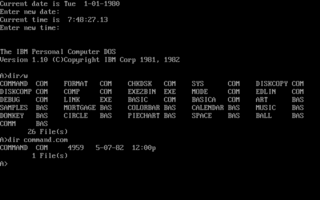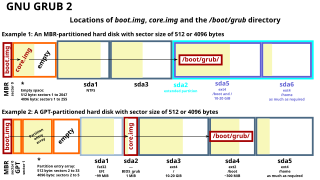
In computing, BIOS is firmware used to provide runtime services for operating systems and programs and to perform hardware initialization during the booting process. The BIOS firmware comes pre-installed on an IBM PC or IBM PC compatible's system board and exists in some UEFI-based systems to maintain compatibility with operating systems that do not support UEFI native operation. The name originates from the Basic Input/Output System used in the CP/M operating system in 1975. The BIOS originally proprietary to the IBM PC has been reverse engineered by some companies looking to create compatible systems. The interface of that original system serves as a de facto standard.
A disk operating system (DOS) is a computer operating system that resides on and can use a disk storage device, such as a floppy disk, hard disk drive, or optical disc. A disk operating system provides a file system for organizing, reading, and writing files on the storage disk, and a means for loading and running programs stored on that disk. Strictly, this definition does not include any other functionality, so it does not apply to more complex OSes, such as Microsoft Windows, and is more appropriately used only for older generations of operating systems.

The Tandy 1000 is the first in a line of IBM PC compatible home computer systems produced by the Tandy Corporation for sale in its Radio Shack and Radio Shack Computer Center chains of stores. Introduced in 1984, the product line was aimed at providing affordable but capable systems for home computing or education, with some of its Tandy specific features like graphics, sound and joystick port making it more appealing for home use.

In computing, booting is the process of starting a computer as initiated via hardware such as a button or by a software command. After it is switched on, a computer's central processing unit (CPU) has no software in its main memory, so some process must load software into memory before it can be executed. This may be done by hardware or firmware in the CPU, or by a separate processor in the computer system.

IBM PC DOS, an acronym for IBM Personal Computer Disk Operating System, is a discontinued disk operating system for the IBM Personal Computer, its successors, and IBM PC compatibles. It was manufactured and sold by IBM from the early 1980s into the 2000s. Developed by Microsoft, it was also sold by that company as MS-DOS. Both operating systems were identical or almost identical until 1993, when IBM began selling PC DOS 6.1 with new features. The collective shorthand for PC DOS and MS-DOS was DOS, which is also the generic term for disk operating system, and is shared with dozens of disk operating systems called DOS.

A boot sector is the sector of a persistent data storage device which contains machine code to be loaded into random-access memory (RAM) and then executed by a computer system's built-in firmware.
A boot disk is a removable digital data storage medium from which a computer can load and run (boot) an operating system or utility program. The computer must have a built-in program which will load and execute a program from a boot disk meeting certain standards.

The Tandy 2000 is a personal computer introduced by Radio Shack in September 1983 based on the 8 MHz Intel 80186 microprocessor running MS-DOS. By comparison, the IBM PC XT used the older 4.77 MHz Intel 8088 processor, and the IBM PC/AT would later use the newer 6 MHz Intel 80286. Due to the 16-bit data bus and more efficient instruction decoding of the 80186, the Tandy 2000 ran significantly faster than other PC compatibles, and slightly faster than the PC AT. The Tandy 2000 was the company's first computer built around an Intel x86 series microprocessor; previous models used the Zilog Z80 and Motorola 6809 CPUs.

The Amstrad PC1512 was Amstrad's mostly IBM PC-compatible computer system, first manufactured in 1986. Next year a slight updated version named PC1640 was introduced. It was also marketed as PC6400, and Sinclair PC500. Schneider branded machines for the German market also exists.

The FM Towns is a Japanese personal computer built by Fujitsu from February 1989 to the summer of 1997. It started as a proprietary PC variant intended for multimedia applications and PC games, but later became more compatible with IBM PC compatibles. In 1993, the FM Towns Marty was released, a game console compatible with existing FM Towns games.
This article details versions of MS-DOS, IBM PC DOS, and at least partially compatible disk operating systems. It does not include the many other operating systems called "DOS" which are unrelated to IBM PC compatibles.

The Rainbow 100 is a microcomputer introduced by Digital Equipment Corporation (DEC) in 1982. This desktop unit had a monitor similar to the VT220 and a dual-CPU box with both 4 MHz Zilog Z80 and 4.81 MHz Intel 8088 CPUs. The Rainbow 100 was a triple-use machine: VT100 mode, 8-bit CP/M mode, and CP/M-86 or MS-DOS mode using the 8088. It ultimately failed to in the marketplace which became dominated by the simpler IBM PC and its clones which established the industry standard as compatibility with CP/M became less important than IBM PC compatibility. Writer David Ahl called it a disastrous foray into the personal computer market. The Rainbow was launched along with the similarly packaged DEC Professional and DECmate II which were also not successful. The failure of DEC to gain a significant foothold in the high-volume PC market would be the beginning of the end of the computer hardware industry in New England, as nearly all computer companies located there were focused on minicomputers for large organizations, from DEC to Data General, Wang, Prime, Computervision, Honeywell, and Symbolics Inc.
A volume boot record (VBR) is a type of boot sector introduced by the IBM Personal Computer. It may be found on a partitioned data storage device, such as a hard disk, or an unpartitioned device, such as a floppy disk, and contains machine code for bootstrapping programs stored in other parts of the device. On non-partitioned storage devices, it is the first sector of the device. On partitioned devices, it is the first sector of an individual partition on the device, with the first sector of the entire device being a Master Boot Record (MBR) containing the partition table.
A self-booting disk is a floppy disk for home computers or personal computers that loads—or boots—directly into a standalone application when the system is turned on, bypassing the operating system. This was common, even standard, on some computers in the late 1970s to early 1990s. Video games were the type of application most commonly distributed using this technique.
RM Nimbus was a range of personal computers from British company Research Machines sold from 1985 until the early 1990s, after which the designation Nimbus was discontinued. The first of these computers, the RM Nimbus PC-186, was not IBM PC compatible, but its successors the PC-286 and PC-386 were. RM computers were predominantly sold to schools and colleges in the United Kingdom for use as LAN workstations in classrooms.

MS-DOS is an operating system for x86-based personal computers mostly developed by Microsoft. Collectively, MS-DOS, its rebranding as IBM PC DOS, and a few operating systems attempting to be compatible with MS-DOS, are sometimes referred to as "DOS". MS-DOS was the main operating system for IBM PC compatibles during the 1980s, from which point it was gradually superseded by operating systems offering a graphical user interface (GUI), in various generations of the graphical Microsoft Windows operating system.

DOS is a family of disk-based operating systems for IBM PC compatible computers. The DOS family primarily consists of IBM PC DOS and a rebranded version, Microsoft's MS-DOS, both of which were introduced in 1981. Later compatible systems from other manufacturers include DR-DOS (1988), ROM-DOS (1989), PTS-DOS (1993), and FreeDOS (1998). MS-DOS dominated the IBM PC compatible market between 1981 and 1995.
A master boot record (MBR) is a special type of boot sector at the very beginning of partitioned computer mass storage devices like fixed disks or removable drives intended for use with IBM PC-compatible systems and beyond. The concept of MBRs was publicly introduced in 1983 with PC DOS 2.0.

The floppy disk is a data storage and transfer medium that was ubiquitous from the mid-1970s well into the 2000s. Besides the 3½-inch and 5¼-inch formats used in IBM PC compatible systems, or the 8-inch format that preceded them, many proprietary floppy disk formats were developed, either using a different disk design or special layout and encoding methods for the data held on the disk.
The IBM Personal Computer Basic, commonly shortened to IBM BASIC, is a programming language first released by IBM with the IBM Personal Computer, Model 5150 in 1981. IBM released four different versions of the Microsoft BASIC interpreter, licensed from Microsoft for the PC and PCjr. They are known as Cassette BASIC, Disk BASIC, Advanced BASIC (BASICA), and Cartridge BASIC. Versions of Disk BASIC and Advanced BASIC were included with IBM PC DOS up to PC DOS 4. In addition to the features of an ANSI standard BASIC, the IBM versions offered support for the graphics and sound hardware of the IBM PC line. Source code could be entered with a full-screen editor, and limited facilities were provided for rudimentary program debugging. IBM also released a version of the Microsoft BASIC compiler for the PC concurrently with the release of PC DOS 1.10 in 1982.